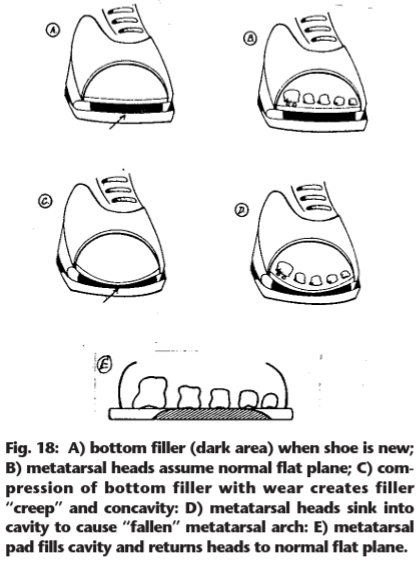How to get to the Root Cause of Neuromas & Other Forefoot Pain
Treating forefoot pain, including Neuromas, Metatarsalgia, Sesamoiditis, etc.
Pain in the forefoot area can be caused by a variety of factors. However, in the case of *most* forefoot issues, it is helpful to understand modern shoe design principles:
Nearly all modern shoes are built with three features that put excess stress  on the forefoot / metatarsal head area of the foot:
on the forefoot / metatarsal head area of the foot:
1) Concave surface underfoot causes middle met heads to sink, crowding bones & nerves. Bridge Soles reverse the concavity, putting your foot back in to a more natural position. Similarly, most shoes have "toe spring" that elevates the toes up in the air above the ball of the foot. Bridge Soles also combat the negative effects of toe spring, by raising the ball of foot area and therefore helping to keep the toes more level.
2)Tapered toe boxes crowd toes towards each other, also straining muscles and nerves, and eventually deforming the bones out of their natural position. Bridge Soles help gently spread your metatarsal heads and toes apart to combat this effect.
3) The elevated heels present in nearly all modern shoes shift significant body weight on to the forefoot. Bridge Soles help spread the pressure out more evenly across the forefoot.

Eventually, most feet come to look like the shoes they wear, & the more shoe-shaped your feet become, the more likely you are to have pain.
For best results, follow these tips to address the root cause and eventually not need to wear Bridge Soles in the future:
- Move toward only wearing shoes that at first feel like there is "too much toe room." Yes, they should feel somewhat uncomfortably loose at first. Even most "wide" shoes still crowd the toes as they are still tapered (wider at the ball & narrower at the toes).
- Work on stretches like the Toe Extensor Stretch or Hammertoe Stretch. These work by releasing the muscles on top of the foot and reversing the harmful effects of excessive toe spring (that keeps your toes up in the air) found in many shoes.
- Wear Correct Toes when active or on your feet. This can be done inside of foot-shaped (not shoe-shaped) shoes. If you can't comfortably wear Correct Toes inside of a shoe---it is likely shaped wrong for your foot or too small, and should not be worn. Also wear Correct Toes without shoes on---to help restore the feet back to their natural position, increase blood flow, and speed up the healing process. Going barefoot whenever possible is preferred---if and when it can be done pain free on soft surfaces like carpet or grass. Wearing shoes that keep your foot in barefoot position (foot-shaped and zero drop) while providing an amount of cushion to simulate being on a natural surface like grass, is preferred at all other times.
- Minimize the time you spend wearing shoes that have tapered toe boxes or elevated heels. Shoes with no heel elevation (zero drop) will also shift weight off the forefoot and are preferred. Examples of foot-shaped shoes would be brands like Altra, Splay, Topo, Xero, Vivobarefoot, Lems, etc. Beware of zero drop shoes that are not truly foot-shaped, as these will not allow your arch to properly support itself and will put excess pressure on the forefoot area.
Using Bridge Soles initially will allow the affected area to relax and be put in to a position where healing can occur. Then, slowly realigning the foot back in to its natural position will allow true restorative healing to occur and Bridge Soles should only be needed for short periods of time if pain reoccurs or for days when you know the foot will get over-stressed. This is both the "quick fix" and the slow, restorative treatment. It will take time and commitment to healthy foot and footwear habits, which many are not willing to do, but it is the only true path to fixing the root cause. Good luck!
Podiatrist Dr. William Rossi used the image above in this article with further information on the relationship between our shoes and our foot problems. Highly recommended reading.
Check out Bridge Soles here.
X-ray image below explaining how most shoes deform the foot out of its natural position, forming a "dagger angle" at the ball of the foot.


